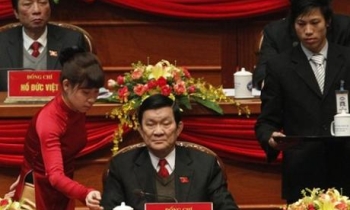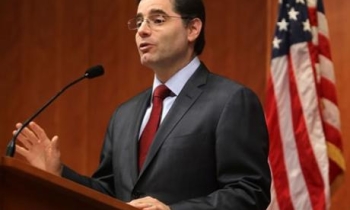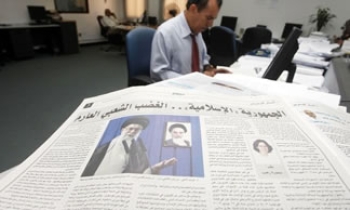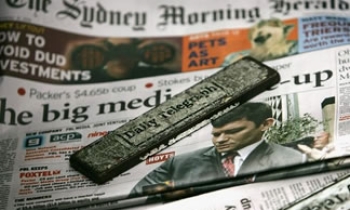NEW YORK: Her day usually starts around 5:30 a.m. in her Montclair, N.J., home, when she consults her Treo to check news from Europe and Asia while many neighbors are still sleeping. After a few quick calls to foreign news bureaus, she heads off to catch the train. It's unlikely that any of her fellow passengers on NJ Transit's Midtown Direct to New York give her more than a passing glance as they peruse the morning papers, tune out with their headphones, or utilize hand-held Web connections. After all, among the commuters from North Jersey to Manhattan, the 51-year-old suburban mother resembles any other fare-paying customer.
But, truth be told, Kathleen Carroll likely has more influence over the content of their news feeds than anyone else in the country.
As executive editor of The Associated Press, the world's largest news organization, Carroll's decisions arguably have more impact on more news reporting than editors of The New York Times, producers at CNN, or the online newsies at Yahoo. And since Carroll took over the top spot in 2002, becoming the first woman at the helm, she has made her mark by instituting a string of changes in AP operations that are among the most significant in the news cooperative's 161-year history. From expanding online services to increasing staff incentives, she has taken one of the oldest news institutions and re-energized it to compete in the growing multimedia age, all the while keeping its old-fashioned news standards intact.
"I feel blessed to have her leading the newsroom at this incredible time in news," says Tom Curley, AP president and the former publisher of USA Today. "She's very strategic -- she has stepped up to the core cultural challenge at AP." And at a time when most news operations are cutting back, AP is expanding in some areas, opening more foreign bureaus, adding to several U.S. offices, and investing in new technology.
Being a "not-for-profit" doesn't hurt that situation, but it does not remove AP completely from the same financial headaches all newsrooms face as they try to compete in the growing Web and technological age. "She's done a lot to adapt AP's newsgathering operation to a changing world," says Bo Jones, publisher of The Washington Post and an AP board member.
Carroll dismisses such accolades, preferring to spread the credit among the more than 3,000 journalists who work for AP, spanning 242 bureaus in 97 countries. Still, her imprint on the news agency's growth in the past four-plus years is clear, both internally and among those who use AP's reportage.
"The staff is very adept at innovation, new ideas, and thinking out beyond the next day's report," Carroll says during a chat in her 14th floor office at AP's Manhattan headquarters, which sits on the edge of Hell's Kitchen. "The first part of change is tough; our industry is really in flux, they are not as committed to a specific format."
But the mechanics of news delivery are only part of the story. Like all major news outlets, AP faces a mix of challenges in today's newsgathering world, including correspondents working in dangerous areas overseas (some 85 staffers in Iraq alone ), anti-press roadblocks in Washington, D.C., and a growing community of media critics that blog and e-mail constantly. Carroll likely spends more time responding to such issues than any of her predecessors. "Trying to sort out how to find the right balance is something every editor I know has wrestled with," she says.
Rachel Zoll still recalls Carroll's first days on the job in 2002. Zoll, who has been with AP for 11 years and currently covers religion for the national desk, remembers the new editor going from desk to desk in AP's previous home at Rockefeller Center, seeking to learn everyone's name. Zoll said a photographer later took shots of staffers that ended up in a directory to easily match names with faces. "She was interested in knowing what everyone was doing," says Zoll. "She came in with a really strong vision, and we are [now] much more focused on hard news, on sharper news judgment."
Others describe Carroll's management style as not overbearing, but not exactly hands-off, either. "She leaves the day-to-day handling of the news report to me," says Managing Editor Mike Silverman. "When there is a big story, she is very involved."
Study first, speak later
Carroll's careful monitoring is clearly on display during the top editors' daily morning news meeting, which is run by Silverman. When E&P visited on a snowy Wednesday in mid-February, all parties gathered inside the glass-enclosed conference room, set a few feet above the massive city-block-sized newsroom.
As the hour-long conference begins, Carroll stands in a corner, nursing a cup of coffee and listening closely to all views, offering input only rarely. The first order of business reflects the newsroom's Web push, as editors review the top stories on Google, Yahoo, and other major sites, counting how many AP stories lead the listings. The recent death of Anna Nicole Smith tops the traffic, followed by a mall shooting and a tornado. Patched in by speakerphone are several bureau chiefs, including Sandy Johnson, who runs the D.C. office.
"I'm in Washington, I have nothing to contribute to the Anna Nicole story," Johnson says, eliciting laughs. But Silverman quickly offers a warning, "Watch, a member of Congress will have a paternity suit."
As the meeting progresses, story plans ranging from coverage of the NBA All-Star game to Oscar previews are discussed, along with ideas for linking many of the stories to ASAP, the AP's new online feature targeting younger readers.
"She is a wonderful combination of good-humored and brilliant journalist, and rigorous enforcer of the mission here," says AP National Editor Brian Toolan, former editor of The Hartford (Conn.) Courant.
Carroll's day at the office starts at around 8 a.m., when she makes some quick online checks, from newspaper Web sites to blogs, to Yahoo and Google news feeds, before the in-person and phone chats begin. Most days, she eats lunch at her desk. On a recent afternoon, meetings included discussions of how to cover the eventual death of Fidel Castro and a review of security protection for some AP television staffers. "It is all stuff that relates to our overall strategic goals," she says.
On the train ride home, Carroll often indulges in one of her favorite newspaper features: The Washington Post's comics, still three pages long and a throwback to her days in D.C.
Updating an institution
Carroll's biggest change since taking over: an overhaul of AP's daily report, which is now concentrated more toward online presentations than anything else. While the news cooperative's legendary "AP Wire" -- which is as old as the use of Morse Code -- is still a main news delivery option, "What we do really works for the next generation on the Web," she says. Carroll notes that AP's history as a 24/7 operation dates back decades: "Breaking news is our bread and butter. We must always do that well. Be first and be right -- or at least right."
With that approach in mind, Carroll set about early to marry the immediacy of the Web with AP's breaking-news doctrine. One move was to do away with the separation of the AP Wire and the online feed. Until 2005, Web editors had to take stories from the Wire, which sends them to all AP customers, and place them into the online feed, which offers immediate access via online news outlets such as Yahoo, Google, and many newspaper Web sites.
That practice ended two years ago, and today anything sent out on the Wire that is slated for the Web is immediately posted online. "We blew up the online desk as a separate desk and put them on the filing desk," Carroll explains. "All internal filing is done with the idea that it will go directly online."
Other Web migration occurred around the same time, including a headline service that requires all reporters to write a 100-word version of each story before diving into the complete report. That enables news to get out within minutes of the reporting being completed, as well as providing a brief account for newspapers. As Carroll points out, "There are newspaper readers who only want that 100 words."
The Web video expansion wasn't far behind. Although Associated Press Television News has been providing video for TV customers since 1994, a separate online video system was not formed until about a year ago. Today, AP's Online Video Network produces 35 to 40 news packages per day, with many used by newspaper Web sites. "We have added several camera crews and videographers around the country," says Silverman, a 35-year AP veteran. Carroll says at least 800 newspapers use AP online news for their Web sites.
"The videos are surprisingly popular," says Ginny Greene, Internet director for The Gazette in Colorado Springs, Colo., which draws some 30,000 page views per month to its AP videos. "It is all about another way to deliver the news."
The online creation that Carroll most likes to show off is ASAP, which launched in 2005, has 26 staffers, and offers a variety of packages and reports targeting the unusual, quirky, and innovative. Initially conceived as AP's answer to the string of youth tabs produced by newspapers in recent years, the service has grown to seek Webbies of all ages.
"It pulls in from a lot of places -- podcasts, freelancers, and newspapers use it any way they can," says Carroll as she surfs the ASAP Web pages on her desktop computer. She points out the service's "drive by shootings," which are collections of photos such as a gallery of wedding images from different nations. "Oh, this is a great one," she snaps, landing on an ASAP page with different images of NBA Star Yao Ming from his native China. "Look, he is everywhere."
But ASAP is not a hit everywhere, according to the Gazette's Greene, who says it gets fewer than 5,000 page views per month. She adds that AP cut her ASAP fee by some 70% after it failed to spark Web traffic: "I thought we would get a little more participation and traction on the site. People may just not understand what it is."
Most recently, AP drew attention by partnering with NowPublic.com, a YouTube-like site that posts information, photos, and video from regular citizens. Carroll stresses that nothing from the site will be used without screening and edits, but supports it as another news option.
Making changes, taking heat
Carroll's fresh approach goes beyond the Web. Many of her efforts and changes have sought to strengthen the AP's reporting and management basics.
Not long after taking over more than four years ago, she created a "Beat of the Week" prize, $500 cash to the story or photo or package that best demonstrates multimedia use and solid reports. "We were looking for ways to add to competitive reporting," she says. "It has been a huge hit and a great reporting device." Winners have included science writer Seth Borenstein, who was covering a climate conference in Paris and broke news of findings confirming humans were responsible for global warming.
A more expansive change has been the news cooperative's Financial Initiative, which launched in 2004 and is expected to increase finance-related staffing by 65 people by year's end. It has increased the level of personal economic news, along with tying more non-business stories to the financial realm.
"Say you have a pipeline fire in Nigeria," Carroll explains. "The financial angle is the effect on companies connected to that pipeline, maybe investors in Nigeria." Curley praises the idea, noting that every bureau is now expected to deliver financial journalism.
Carroll also made a push for more "high-impact" enterprise reporting, claiming that it is one way AP can distinguish itself beyond breaking news: "For a story to be meaningful, it is not enough to say, 'this happened today.'" She often talks of the "arc of a story," literally waving her arm to form a half-circle, stressing the need for coverage to follow its course on important issues.
And those enterprise reports need to be as multimedia as possible: "I want to get you whatever way I can," she says about potential reader/viewers. "If it is video, great. If it is sound, great. If it is text, great. Sometimes the video is the story."
For some staffers, however, AP's changing approach may be too much, too fast. "People are being asked to do more with less, and resources around the country are getting very tight," says Tony Winton, a Miami-based broadcast reporter and president of the News Media Guild, which represents about 1,600 AP staffers. "It is almost like it is happening too fast; you are trying to walk out the door before you open it."
Winton notes a buyout last year that ended with the departure of about 100 technical staffers. He also says a number of state bureaus have lost people in posts that remain unfilled: "The company has told us it will not hurt journalistic standards, but we are concerned." AP also took some heat in February when it ended its book review package. The news cooperative said at the time the move was part of a features reorganization, but it drew complaints from a handful of publishers and editors.
Then there's the dispute over Chris Graff, the former AP Vermont bureau chief who was fired last year after 27 years as an AP employee. He lost his job after he distributed a column on open government by Sen. Patrick Leahy and allowed a staffer to contribute to a 2003 book about Howard Dean. Carroll has continually declined to comment on the firing, which raised interest when numerous Vermont newspaper editors and politicians complained to AP and urged that Graff be rehired. (He never was, and currently works at an insurance company.)
As a news cooperative, AP is technically a "not-for-profit," and is actually owned by its 1,600 or so member newspapers, each of which pays various fees to use content, but also provide content when needed. Their payments reflect one-third of the news organization's revenue, along with another third from broadcast clients and the final piece from a mix of online, international, and commercial customers. Although AP does not seek the high profit margins of some chains, it still must contend with financial constraints and those of its members, a situation that caused the co-op in 2006 not to raise its fees for members for the first time since 1971.
It's only rock 'n' roll
Born in 1955 in Hattiesburg, Miss., Carroll leans more on her Texas background, noting she moved to the Lone Star State at age 2. The oldest of three girls, Carroll grew up in Dallas as the daughter of a schoolteacher and an accountant. After graduating from high school, her first taste of paid journalism came at The Dallas Morning News, where she started just months after getting her high school diploma and stayed throughout her college years.
"I had wanted to be a journalist for as long as I could remember, after ballerina," Carroll recalls. "I liked finding stuff out and telling people about it -- uber-gossip." After a year at Dallas Baptist University, Carroll switched to the University of Texas at Arlington. But the entire time, the Morning News had her on the job, at one point working nights writing up obits, weather stories, and anniversaries. By her senior year, she quit school to work full time at the paper.
"The great news war in Dallas was going on in those days," she recalls. "It was a great way to get started -- a knock-down, drag-out fight." She was one of the few women police reporters at the time, but she says her gender never resulted in hazing from male staffers on the beat, or from officers.
In 1978, she took her first AP post in the Dallas bureau, juggling desk work and breaking news until 1980 when she was transferred to the Newark, N.J., bureau and appointed a news editor. "I had to try to learn to talk so someone in New Jersey could understand me," she says of her Texas twang, which still exists in a milder form.
Two years later, the West Coast came calling -- and Carroll became an editor in the AP's Los Angeles bureau. "You couldn't make these things up," she recalls about the scandals and stars involved in stories there. "You had all these great stories, and earthquakes and fires."
Linda Deutsch, AP's longtime L.A. correspondent who specializes in sensationalistic court events, remembers Carroll running the bureau in a professional but aggressive manner. "She's a total pro, very supportive of her staff, and she understands what news is about," Deutsch says. "In those days, we were always fighting against UPI for scoops. She was always a great ally, someone to have on your side." Deutsch cites Carroll's guidance on efforts to get access to court records in the John DeLorean case, in which the auto designer was accused of cocaine trafficking, but acquitted. AP went to court in a landmark case that ended with the news bureau obtaining the records.
It was in California where Carroll met her future husband Steve Twomey, then the west coast bureau chief for The Philadelphia Inquirer (he now teaches at New York University). When the Inquirer shipped Twomey off to Paris as a foreign correspondent, Carroll went with him, and eventually joined the International Herald Tribune as a business desk editor.
The couple married in 1985, and in 1987 moved back to California -- where Carroll signed on with the San Jose (Calif.) Mercury News as an assistant city editor. Twomey also eventually landed a post at the paper, and the couple lived there until 1988.
Then, Carroll says, the fun of working in a newsroom stopped. "I kind of got burned out on journalism, and quit the life," she says, noting the pressures of middle management. "It didn't feel like rock 'n' roll anymore. The impact seemed like it had gotten small, the victories were small and did not balance out the pain-in-the-butt quotient." At 33, Carroll quit the paper, the couple sold their house, and went on a three-month tour of Southeast Asia. They returned to the U.S. and in 1989 Twomey landed a job at The Washington Post.
"I was trying to figure out a new career," Carroll recalls about her initial time in D.C. "While looking at other things, I got my groove back about journalism. You realize the cycle of journalism and the reach of it, the wide-open palette you have to be curious about things that isn't present in any other field." Carroll returned to AP in 1990, joining the Washington bureau as an editor overseeing government coverage -- a post she held until her son, Nicholas, was born in 1995.
After six months off post-baby, she went to work for Knight Ridder, first as Washington bureau news editor, then bureau chief, the post she held in 2002 when she jumped to AP's top spot. Carroll says the joys of Washington had hit their limits: "You can stay too long in Washington if Washington is not your ultimate destination. I wanted to run a newsroom, and I was casting around to do so."
AP leaders also were casting around to find a replacement for then-Executive Editor Jon Wolman, now editorial page editor at the The Denver Post. Wolman, along with then-president Lou Boccardi, contacted Carroll. "She had shown to have strong editing skills, was well regarded with Knight Ridder, and it looked as though she had a good blend of seasoning we were looking for," says Boccardi. "I remember her being direct about news matters and having good news instincts."
Battling criticism, inaccuracy
Carroll's demeanor mixes tough-talking news leader with a calm management style. Staffers say she'll toss an assignment in someone's lap ordering them to "make it happen" one minute, but drop everything to offer support and guidance the next.
She is also known for backing up her people when they come under fire. With journalists constantly in danger as well, she is often first to get on the phone, or the plane, when someone is in trouble. "I don't think it is an automatic to stand by a reporter," Carroll says about her style in the face of critics. "But it is not right to publicly disembowel someone. The idea of standing by a reporter assumes that they are under assault all the time and they are not, or that they are always right, which they are not."
Her push for accuracy also led to the creation of a correction database that tracks corrections by geography, cause, and other criteria, and is constantly analyzed for ways to improve and prevent errors. "We look at where this is happening and why," she explains. "Is editing too aggressive? Is information not coming in too clearly?"
At a time when media criticism is skyrocketing, including the growing microscope on AP, Carroll says it is important to respond to complaints and mistakes, but not in a way that is overly reactive. "When you get a lot of eyes on something, you are going to find flaws," she says. "There are a lot of thoughtful people out there who are seeing and consuming news, and there are a lot of good voices to have in the conversation." Still, she stresses some readers with critiques have a clear agenda: "There is a whole group of people who are pissed off, and are not going to like what I say."
Among them is probably syndicated columnist and blogger Michelle Malkin, who led a drive challenging AP's repeated use of a police source in Iraq, Jamil Hussein, who had provided information on several stories. In late 2006, Malkin and other conservative critics challenged Hussein's existence and publicly ripped AP, even visiting Iraq to claim Hussein's information was false. "A barometer can be if it's a question of fact or of our motive," Carroll says about the Hussein dispute. "We always take questions of fact seriously."
AP president Curley points to Carroll's leadership and strength in the face of personal dangers facing her staff, which he dubs "tough people situations." Carroll "first gathers the facts and allows them to lead to a decision without jumping to conclusions," he says, citing her calm demeanor during the capture of photographer Emilio Morenatti in Gaza in late 2006. The AP learned of the kidnapping after midnight, Curley recalls, and he joined Carroll and others at AP headquarters in Manhattan at about 4 a.m. to work the phones and seek his release. "It was a pleasure to work through a situation with someone who is not overwhelmed and asks a lot of tough questions," adds Curley. After discussions with the Spanish foreign minister and Palestinian diplomats, Morenatti was eventually released that evening.
Of 'fake secrecy' and Iraq
But not all AP personnel disputes have ended so easily. Among Carroll's continuing crusades is the release of Bilal Hussein, an AP reporter in Iraq who was captured by Iraqi officials nearly a year ago, but has yet to be charged with any formal crime. He is accused of aiding insurgents, but Carroll and AP have yet to find any specific incident in which he is involved. "He is never out of our thoughts," she reveals. At one point late last year, Carroll publicly urged newspapers to editorialize about Hussein's plight, a move that prompted several editorial writers to weigh in.
Iraq weighs heavily on Carroll's mind, she admits. Along with Bilal Hussein, she says the lives of the other 84 AP personnel in the country remain uppermost in her daily thoughts. "I believe that Baghdad today, and for some time, is the most dangerous story in a sustained way that AP has covered," she declares, adding that four AP employees have been killed in Iraq since the U.S. invasion. "The threats to our staffers come from everywhere you can imagine, and it is going to get worse."
Still, Carroll says the number of AP staffers there is likely to increase this year by at least a few. "We have always had somebody embedded," she says, adding that the Baghdad bureau relocated from a hotel to a house last summer in an effort to find better security. She has yet to visit Baghdad, although travel takes up between six and eight weeks of her time each year; she plans to return to China this spring when the Beijing bureau is expanded. "They don't need me to oversee coverage," she says of the Baghdad bureau. "I would like to go to salute the coverage."
Another journalistic concern AP shares with other news outlets is the ongoing secrecy in Washington, as well as the increased attacks on the press by the Bush Administration, along with demands for reporters' sources and information.
"It is a more adversarial and more restrictive environment than I can remember in the 30-plus years I have been doing it," Carroll says as she bites into a foccacia sandwich during lunch at a nearby bar and grill. "The climate in Washington can be built to accentuate this kind of restriction; it doesn't matter which party is in office."
She singles out the recent attention on background briefings by government officials who insist on anonymity, specifically government claims in February that Iran was involved in supplying weaponry to Iraq. "Readers deserve the accountability of knowing who is saying what," she says. "It's crap, the argument that the only way we are going to get this is to agree to go along, it allows this attitude of fake secrecy.
"There is an overall [government] tendency to deny information to taxpayers about what they are doing," Carroll adds. "I think it is worse now; it has made it harder for local reporters and average citizens."
As for the future, she sees AP campaign coverage in 2008 simply expanding upon what it has done in the past, and cites blogs and Web sites used by the candidates as "helpful, the more avenues they have, the better." She says reporters just have to offer information and news beyond what the Web is providing. "You have to be there, know the candidates and the issues, and all of that doesn't change," she explains. "The effort to make the information accessible and available to people never stops."
But what about her own future? She's not seeking to step down any time soon, but adds, "I want to have a whole bunch of people be great candidates to be a great editor when it's time for me to leave."
Joe Strupp (jstrupp@editorandpublisher.com) is a senior editor at E&P.









